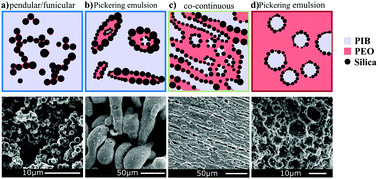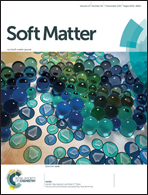A microstructure-composition map of a ternary liquid/liquid/particle system with partially-wetting particles†
Abstract
We examine the effect of composition on the morphology of a ternary mixture comprising two molten polymeric liquid phases (polyisobutylene and polyethylene oxide) and micron-scale spherical silica particles. The silica particles were treated with silanes to make them partially wetted by both polymers. Particle loadings up to 30 vol% are examined while varying the fluid phase ratios across a wide range. Numerous effects of particle addition are catalogued, stabilization of Pickering emulsions and of interfacially-jammed co-continuous microstructures, meniscus-bridging of particles, particle-induced coalescence of the dispersed phase, and significant shifts in the phase inversion composition. Many of the effects are asymmetric, for example particle-induced coalescence is more severe and drop sizes are larger when polyisobutylene is the continuous phase, and particles promote phase continuity of the polyethylene oxide. These asymmetries are likely attributable to a slight preferential wettability of the particles towards the polyethylene oxide. A state map is constructed which classifies the various microstructures within a triangular composition diagram. Comparisons are made between this diagram vs. a previous one constructed for the case when particles are fully-wetted by polyethylene oxide.



 Please wait while we load your content...
Please wait while we load your content...